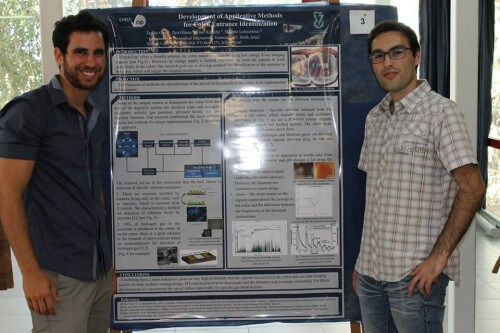The two studied the known indicators that indicate this transition and isolated two indicators that are sufficient for such a precise determination: (1) the release of specific enzymes and (2) the emission of hydrogen and methane. These indicators allow an accurate launch of the capsule and starting work in exactly the right place.

Ilya Glanz and Zafir Ozer are the first place winners in the project competition of the Faculty of Biomedical Engineering at the Technion. The award was given to them for a project they developed in collaboration with the Checkup company: an innovative method for accurately locating the opening of the intestine. "Such accurate detection is necessary when using an imaging pill that scans the colon," Ozer explains. "Such pills have limited energy, so it is important that they start working when they pass from the small intestine to the opening of the large intestine and not before." The two studied the known indicators that indicate this transition and isolated two indicators that are sufficient for such a precise determination: (1) the release of specific enzymes and (2) the emission of hydrogen and methane. These indicators allow an accurate launch of the capsule and starting work in exactly the right place.
The competition was held as part of the faculty's annual project conference, and the prizes were awarded by the Cbyond company. The second place was won by the students Ilya Galft and Adi Sandelson. The two developed for the Hanita lens company a device that measures the speed of flow through the company's implant. This implant treats wide-angle glaucoma, which is characterized by a disturbance in the drainage channels of the aqueous intraocular fluid. Third place was won by three groups: Vared Ezer and Adi Raz, who carried out their project in Prof. Dan Adam's laboratory in the Faculty of Biomedical Engineering, developed software based on learning dictionaries for the automatic classification of different views of echocardiograms. Gilan Grimberg and Uri Mardler, who carried out their project in the laboratory of Prof. Shulamit Levenberg from the Faculty of Biomedical Engineering, developed software that studies and characterizes the morphology of three-dimensional structures of nerves and blood vessels. Shahar Ravsky, who carried out his project at IDOS, researched and analyzed the various features of the shoulder joint implant produced by the company.
Prof. Amir Landsberg, Dean of the Faculty of Biomedical Engineering at the Technion, said that "the project conference is being held with the aim of encouraging initiative and creativity among the students and strengthening the relationship between the faculty and relevant companies in the industry and medical institutions. These bodies take part in many of the projects and thus are exposed to students who are the engineers of the future in the field of biomedical engineering."
Dr. Alex Wilensky, in charge of the projects course, said that "the projects, which express the knowledge and tools that the students have acquired in the fields of engineering, science and medicine, are the highlight of the degree studies. In many cases, the project is the first step in registering a patent and establishing a start-up company."
Other projects presented at the conference are a system for measuring temperature during plastic surgery (in collaboration with the Lumenis company), semi-automatic image processing for mapping anatomical structures in MRI imaging of breast cancer tumors (in collaboration with Insightek), a polymeric sticker for measuring oxygen in the skin, and imaging of optogenetic excitation of The cortical neurons.
